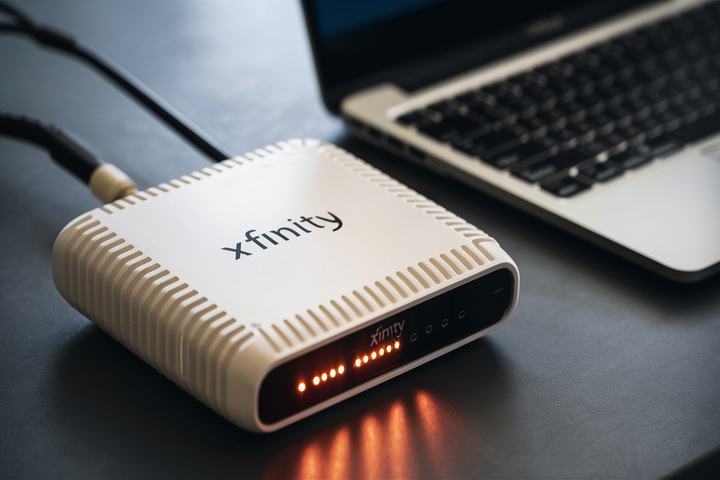What is the lifespan of a Xfinity modem?

The lifespan of a Xfinity modem typically ranges from 3 to 5 years, though this can vary based on usage, environmental factors, and model. Understanding modem longevity is crucial for maintaining optimal internet speeds and avoiding costly upgrades. This article explores factors influencing Xfinity modem lifespan, signs of aging, and strategies for maximizing its performance and duration in 2025.
Understanding Your Xfinity Modem's Lifespan: A 2025 Perspective
In the ever-evolving landscape of home internet connectivity, the modem stands as a silent, yet vital, workhorse. For Xfinity subscribers, understanding the expected lifespan of their modem is not just a matter of curiosity; it's a key factor in ensuring consistent, high-speed internet access and avoiding unexpected costs. As we navigate 2025, the average lifespan of a Xfinity modem, whether rented from the provider or purchased outright, generally falls within the 3 to 5 year range. However, this figure is not a rigid rule but rather a statistical average influenced by a multitude of variables. These can include the specific model of the modem, the intensity of its daily use, the environmental conditions it operates in, and even the inherent quality of its components. For instance, a modem constantly pushed to its limits to support multiple high-bandwidth activities like 4K streaming, online gaming, and extensive smart home device usage will likely experience wear and tear more rapidly than one used for basic browsing and email. Similarly, a modem situated in a poorly ventilated area, exposed to extreme temperatures, or susceptible to power surges will inevitably have a shorter operational life. This article aims to demystify the lifespan of Xfinity modems, providing a comprehensive overview of the factors that contribute to their longevity, the tell-tale signs that indicate a modem is aging, and practical strategies to extend its useful life, all viewed through the lens of current 2025 technology and user expectations. By the end of this guide, Xfinity customers will be better equipped to make informed decisions about their home networking equipment, ensuring a seamless and efficient internet experience.
The technology powering our internet connections is advancing at an unprecedented pace. In 2025, the demands placed on modems are significantly higher than just a few years ago. With the proliferation of 8K streaming, cloud gaming, advanced virtual reality applications, and an ever-growing number of connected smart home devices, the need for robust and up-to-date networking hardware is paramount. Older modems, even if still technically functional, may struggle to keep up with these bandwidth-intensive applications, leading to frustrating slowdowns and connectivity issues. Therefore, the concept of modem lifespan is intrinsically linked to technological obsolescence as much as physical degradation. A modem that was top-of-the-line in 2020 might be considered outdated by 2025 standards, not because it's broken, but because it can no longer efficiently handle the latest internet protocols and speed requirements. This is particularly relevant for Xfinity subscribers who are often on plans offering speeds that older modems simply cannot support. For example, if you've upgraded your Xfinity internet plan to gigabit speeds, your older modem might be a significant bottleneck, even if it's only a few years old. Understanding this dual nature of modem lifespan—physical endurance and technological relevance—is crucial for any consumer looking to optimize their home network in 2025.
The Crucial Factors Influencing Modem Longevity
Several key factors contribute to how long a Xfinity modem will effectively serve its purpose. Understanding these can help users proactively manage their equipment and potentially extend its lifespan.
1. Model and Technology Standards
The most significant factor is the modem's underlying technology. Modems adhering to newer standards, such as DOCSIS 3.1, are built with more advanced components and are designed to handle higher speeds and greater network efficiency. These are generally more robust and have a longer projected lifespan compared to older DOCSIS 3.0 modems. In 2025, DOCSIS 3.1 is becoming the standard for high-speed internet, and modems supporting this standard are more likely to remain relevant and functional for a longer period. Older modems might be phased out by Xfinity due to their inability to support newer network requirements, regardless of their physical condition. For instance, Xfinity is actively encouraging upgrades to DOCSIS 3.1 to support its multi-gigabit internet tiers. A DOCSIS 3.0 modem, even if it's only 3 years old, might be considered end-of-life by the ISP for certain service levels.
2. Usage Intensity and Network Load
How much you use your modem and the demands you place on it directly impact its wear and tear. A modem in a household with a single user performing basic web browsing will experience less stress than a modem in a busy household with multiple users simultaneously streaming 4K video, downloading large files, engaging in competitive online gaming, and supporting numerous smart home devices. Higher network traffic and constant data processing generate heat and put more strain on internal components, accelerating degradation. Think of it like a car engine: one driven gently for short commutes will last longer than one constantly driven at high speeds or used for heavy hauling. In 2025, with the average number of connected devices per household continuing to rise, this factor is more critical than ever.
3. Environmental Conditions
The physical environment where your modem is placed plays a significant role. Modems are sensitive electronic devices. Exposure to extreme temperatures (both hot and cold), high humidity, dust, and direct sunlight can degrade internal components over time. Overheating is a particularly common issue. Modems often generate heat during operation, and if they are placed in enclosed spaces like cabinets without adequate ventilation, or near heat sources (like other electronics or direct sunlight), their internal temperature can rise to damaging levels. This can lead to performance issues, instability, and ultimately, premature failure. Similarly, power surges, even minor ones, can damage sensitive circuitry. Using a surge protector is a simple yet effective way to mitigate this risk.
4. Power Quality and Surges
The stability of your home's electrical supply is crucial. Frequent power fluctuations, brownouts, or sudden surges can inflict significant damage on electronic components. A modem is constantly powered on, making it particularly vulnerable. While modern modems have some built-in protection, severe or frequent power events can overwhelm these safeguards. Investing in a quality surge protector or a UPS (Uninterruptible Power Supply) can provide an essential layer of defense against these damaging electrical disturbances. This is a relatively low-cost measure that can significantly extend the life of your modem and other sensitive electronics.
5. Maintenance and Firmware Updates
While users have limited direct maintenance options for modems, ensuring they receive regular firmware updates is critical. ISPs like Xfinity push these updates remotely to improve performance, patch security vulnerabilities, and enhance compatibility with network changes. If your modem is not connected to the internet or if Xfinity's update process is interrupted, it might not receive these crucial updates, potentially leading to performance degradation or compatibility issues. For purchased modems, users might need to check manufacturer websites or Xfinity's compatibility lists to ensure they are running the latest approved firmware. Physical maintenance, such as dusting the vents periodically, can also help prevent overheating.
6. Manufacturing Quality and Component Lifespan
Just like any electronic device, the quality of components used during manufacturing varies. Higher-end modems, often those purchased outright from reputable brands, may use superior components that are designed for greater durability and longevity. Conversely, lower-cost models or those provided as basic rental equipment might use less expensive parts that are more prone to failure over time. The lifespan of specific components, such as capacitors, can be affected by heat and electrical stress. While difficult for a consumer to ascertain without detailed technical specifications, brand reputation and reviews can offer some indication of manufacturing quality.
Signs Your Xfinity Modem Might Be Nearing Its End (2025 Edition)
Recognizing the symptoms of an aging or failing modem is crucial for proactive replacement and avoiding prolonged internet disruptions. In 2025, with increasingly complex network demands, these signs might become more pronounced.
1. Frequent Internet Disconnections
This is perhaps the most common and frustrating symptom. If your internet connection drops out multiple times a day, requiring you to reset the modem or router, it's a strong indicator of a problem. While router issues can cause similar symptoms, consistent modem reboots that resolve the issue temporarily often point to the modem itself being the culprit. This can be due to internal component failure or an inability to maintain a stable connection with Xfinity's network infrastructure.
2. Slow Internet Speeds That Can't Be Explained
You've checked your Xfinity plan, run speed tests, and confirmed you're paying for speeds that you're not receiving. If your download and upload speeds are consistently lower than they should be, even after troubleshooting your router and devices, the modem might be a bottleneck. An aging modem may struggle to process data efficiently or maintain optimal signal levels, leading to reduced throughput. This is especially noticeable in 2025 as users expect higher speeds for demanding applications.
3. Inconsistent Performance and Lag
Beyond just slow speeds, you might experience inconsistent performance. This can manifest as sudden lag spikes during online gaming, buffering during video streams that resolves itself, or general unresponsiveness from websites. These issues can arise when the modem struggles to handle fluctuating data demands or maintain stable packet delivery. A failing modem might be able to establish a connection, but it can't sustain a high-quality, stable one.
4. Overheating Issues
If your modem feels unusually hot to the touch, even after ensuring it's in a well-ventilated area, this could be a sign of internal problems. Overheating can be caused by failing components working harder than they should or by a general decline in efficiency. Prolonged overheating can accelerate further damage and lead to more severe issues or complete failure.
5. Indicator Light Anomalies
Modems have indicator lights that show their operational status (power, downstream, upstream, internet connection, etc.). If these lights are behaving erratically – flashing when they should be solid, off when they should be on, or displaying unusual color patterns – it signifies a problem. Consult your modem's manual or Xfinity's support documentation for the meaning of specific light patterns. For example, a solid downstream and upstream light but no internet light might indicate a modem-to-ISP communication issue, often related to the modem itself.
6. Modem Becomes Unresponsive to Resets
A common troubleshooting step is to power cycle (reboot) the modem. If rebooting no longer resolves connectivity issues, or if the modem takes an exceptionally long time to come back online after a reset, it suggests that the device is struggling to initialize properly. This can be a sign of hardware degradation.
7. Incompatibility with Newer Xfinity Services or Speeds
Even if the modem is physically functional, it might be considered "end-of-life" by Xfinity if it doesn't support the latest DOCSIS standards or the speeds of your current internet plan. Xfinity periodically updates its network and may deprecate support for older modem technologies. If you've recently upgraded your internet speed or Xfinity has announced network upgrades in your area, and you experience issues, your modem's technological capabilities might be the limiting factor.
Xfinity Modem Lifespan vs. ISP-Provided Equipment: What's the Difference?
When it comes to Xfinity internet, users typically have two main options for their modem: renting equipment directly from Xfinity or purchasing their own compatible modem. Each approach has implications for modem lifespan, cost, and management.
Renting from Xfinity
When you rent a modem from Xfinity, you are essentially leasing their hardware. The typical monthly rental fee can add up significantly over the years. A key advantage of renting is that Xfinity is responsible for maintaining and replacing the equipment if it fails or becomes obsolete. If your rented modem stops working or is no longer supported by Xfinity's network, they will typically replace it with a newer, compatible model at no additional charge (beyond the ongoing rental fee). This means you don't have to worry about the physical lifespan of the device as much, as Xfinity manages the upgrade cycle. However, this convenience comes at a recurring cost. Over a 3-5 year period, rental fees can often exceed the cost of purchasing a modem outright. Furthermore, Xfinity may dictate which models are provided, and these might not always be the latest or most feature-rich options available on the market.
Purchasing Your Own Modem
Purchasing a modem offers greater control and potential long-term cost savings. You can select a modem that meets your specific speed requirements and desired features, often opting for higher-end models with better performance and longevity. However, when you own the modem, you are solely responsible for its lifespan and replacement. If it fails, becomes outdated, or is no longer supported by Xfinity, you will need to purchase a new one. This requires staying informed about Xfinity's compatibility lists and technological requirements (like DOCSIS standards). The lifespan of a purchased modem is entirely dependent on the factors discussed earlier: usage, environment, and inherent quality. While you avoid monthly rental fees, the initial investment is higher, and you bear the risk of premature failure or technological obsolescence. In 2025, with rapid advancements in internet technology, users who purchase their own modems need to be particularly vigilant about ensuring their device remains compatible with Xfinity's evolving network.
Key Differences Summarized
- Responsibility for Replacement: Rented = Xfinity; Purchased = You.
- Cost Structure: Rented = Ongoing monthly fees; Purchased = One-time upfront cost.
- Equipment Choice: Rented = Limited Xfinity options; Purchased = Wider market selection.
- Technological Obsolescence: Rented = Xfinity typically upgrades; Purchased = You manage upgrades.
- Maintenance: Rented = Xfinity handles issues; Purchased = You troubleshoot/replace.
Maximizing Your Xfinity Modem's Performance and Lifespan: A Practical Guide
Whether you rent or own your Xfinity modem, there are several practical steps you can take to ensure it performs optimally and lasts as long as possible. These strategies focus on mitigating common causes of degradation and ensuring the device operates under ideal conditions.
1. Optimal Placement for Ventilation and Stability
Avoid placing your modem in enclosed cabinets, dusty areas, or near heat-generating appliances. Ensure there is ample airflow around the device. A well-ventilated, cool, and dry location is ideal. Consider placing it on a hard, flat surface rather than carpet, which can obstruct airflow and attract dust.
2. Protect Against Power Surges
Connect your modem (and router) to a high-quality surge protector. This simple measure can prevent damage from electrical spikes, which can significantly shorten a modem's lifespan. For added protection, especially in areas prone to power outages or fluctuations, consider an Uninterruptible Power Supply (UPS). A UPS not only protects against surges but also provides battery backup, allowing for a graceful shutdown during power loss, preventing data corruption and stress on the hardware.
In 2025, with increasingly sophisticated electronic components in modems, protection against even minor power fluctuations is more important than ever. A surge protector is a relatively inexpensive investment that can save you the cost and hassle of replacing a damaged modem.
3. Regular Reboots (When Necessary)
While not a daily necessity, periodically rebooting your modem can help clear temporary glitches and refresh its connection to Xfinity's network. A weekly or bi-weekly reboot, especially if you notice minor slowdowns, can sometimes improve performance. However, avoid excessive rebooting, as it can put unnecessary strain on the device.
4. Keep Firmware Updated
For purchased modems, regularly check the manufacturer's website or Xfinity's compatibility portal for firmware updates. For rented modems, Xfinity typically manages this remotely, but ensure your modem is powered on and connected to the internet to receive these updates. Firmware updates often include performance enhancements, bug fixes, and security patches that can improve stability and longevity.
5. Avoid Overloading the Modem
While modems are designed to handle significant loads, consistently pushing them to their absolute limits for extended periods can accelerate wear. If you frequently experience performance issues during peak usage times, consider if your modem is adequately equipped for your household's demands. This might involve upgrading to a more powerful modem or ensuring your internet plan aligns with your usage needs.
6. Clean Vents and Exterior
Occasionally, gently dust the exterior and vents of your modem using a soft, dry cloth or compressed air. This helps maintain optimal airflow and prevents dust buildup that could contribute to overheating.
7. Use Quality Coaxial Cables
Ensure the coaxial cable connecting your modem to the wall outlet is in good condition, free from kinks or damage, and properly secured. Using older or damaged cables can degrade signal quality, putting extra strain on the modem.
When to Consider an Upgrade: Beyond the Lifespan
While the average lifespan of a Xfinity modem is 3-5 years, the decision to upgrade should not solely be based on age. Several factors, particularly relevant in 2025, warrant considering a new modem even if your current one is technically still functioning:
1. Upgrading Your Xfinity Internet Plan
If you've recently upgraded to a faster Xfinity internet plan (e.g., from a 300 Mbps plan to a gigabit plan), your older modem might be a significant bottleneck. Even if it's only 2-3 years old, a DOCSIS 3.0 modem may not be capable of delivering the advertised speeds of a DOCSIS 3.1-based plan. Xfinity provides a list of compatible modems for each speed tier; check this list to ensure your current modem meets the requirements.
2. Technological Obsolescence (DOCSIS Standards)
The internet technology landscape is constantly evolving. DOCSIS 3.0 has been the standard for years, but DOCSIS 3.1 is now prevalent for higher speeds, and DOCSIS 4.0 is on the horizon. If your modem is only DOCSIS 3.0 compatible, it might struggle to efficiently handle the increasing data demands of modern internet usage, even if it's physically sound. Xfinity is actively pushing DOCSIS 3.1 adoption to support faster speeds and improve network efficiency. By 2025, many users will benefit significantly from the improved performance and capacity of DOCSIS 3.1 modems.
3. Increased Number of Connected Devices
As smart home technology becomes more integrated into our lives, the number of devices connected to your home network increases dramatically. Each device consumes bandwidth and requires reliable connectivity. An older modem might struggle to manage the traffic from numerous devices simultaneously, leading to degraded performance for all connected devices. If your household has many smart devices, streaming boxes, gaming consoles, and mobile devices, an upgrade might be necessary.
4. Experiencing Persistent Performance Issues
If you've tried all troubleshooting steps—rebooting, checking router settings, verifying cable connections—and still experience frequent disconnections, slow speeds, or lag, your modem is a prime suspect. Even if it's within the typical lifespan, a faulty unit might require replacement. It's often more cost-effective and less frustrating to replace a problematic modem than to endure subpar internet service.
5. Desire for Advanced Features
Newer modems, especially combination modem/router units (gateways), often come with enhanced features such as Wi-Fi 6 or Wi-Fi 6E support, improved security protocols, and better network management capabilities. If these advanced features are important for your home network performance and security, it might be time to consider an upgrade.
6. Xfinity Equipment Mandates
Occasionally, Xfinity may mandate that subscribers upgrade their equipment to maintain service, especially if older modems pose a security risk or are incompatible with network upgrades. While less common for functioning modems, it's a possibility to be aware of.
The Future of Modems: What to Expect in the Coming Years
The evolution of internet technology is relentless, and modems are at the forefront of this change. As we look beyond 2025, several key trends are shaping the future of modem technology, impacting their lifespan and capabilities.
1. Widespread Adoption of DOCSIS 4.0
Following DOCSIS 3.1, DOCSIS 4.0 is the next major iteration of the cable modem standard. It promises even higher speeds, improved latency, and enhanced network capacity, potentially enabling symmetrical multi-gigabit speeds (e.g., 10 Gbps download and 10 Gbps upload). Modems supporting DOCSIS 4.0 will likely have a longer effective lifespan as they are designed for the next generation of internet demands. ISPs like Xfinity will gradually roll out support for this standard, making DOCSIS 4.0 modems a wise investment for future-proofing home networks.
2. Integration of Wi-Fi Technologies
The trend of integrating modem and router functionalities into a single gateway device is likely to continue and become more sophisticated. Future gateways will incorporate the latest Wi-Fi standards, such as Wi-Fi 7, offering faster wireless speeds, lower latency, and better handling of multiple devices. This convergence simplifies home networking setups but also means that the lifespan of the entire unit is tied to both modem and Wi-Fi technology advancements.
3. Increased Focus on Security
As cyber threats become more sophisticated, future modems and gateways will likely feature enhanced built-in security measures. This could include advanced firewalls, intrusion detection systems, and automated security updates. This focus on security will be crucial for protecting home networks from emerging threats, making security features a key consideration in modem longevity and relevance.
4. Smarter Network Management and AI Integration
Expect modems to become "smarter," potentially incorporating artificial intelligence (AI) for network optimization. AI could help manage bandwidth more efficiently, predict and resolve connectivity issues proactively, and tailor network performance to user needs. This could lead to a more seamless and reliable internet experience, potentially extending the perceived usefulness of a modem.
5. Energy Efficiency
With growing environmental awareness, future modem designs will likely prioritize energy efficiency. Manufacturers will strive to create devices that consume less power without compromising performance, aligning with broader sustainability goals.
6. Longevity and Sustainability Considerations
As the electronics industry faces scrutiny over e-waste, there may be a greater emphasis on designing modems for longer lifespans and easier repairability. This could involve modular designs or more robust components, although the rapid pace of technological advancement often drives obsolescence before physical failure.
Conclusion
The lifespan of a Xfinity modem is not a fixed number but rather a dynamic range influenced by a confluence of factors, typically falling between 3 to 5 years in 2025. This duration is shaped by the modem's underlying technology (DOCSIS standards), the intensity of its daily use, environmental conditions, power stability, and manufacturing quality. Recognizing the signs of an aging modem—such as frequent disconnections, persistent slow speeds, overheating, or erratic indicator lights—is paramount for maintaining a reliable internet connection and avoiding frustration. Whether you rent your modem from Xfinity or purchase your own, understanding these factors empowers you to make informed decisions. Renting offers convenience and automatic replacements, but at a recurring cost, while purchasing provides greater control and potential long-term savings, albeit with the responsibility for managing upgrades and replacements. To maximize your modem's performance and extend its useful life, prioritize optimal placement for ventilation, protect it against power surges with a quality surge protector, ensure firmware is up-to-date, and avoid consistently overloading the device. As technology advances rapidly, consider upgrading not just based on age, but also on your internet plan speed, the number of connected devices, and the emergence of newer standards like DOCSIS 3.1 and beyond. By proactively managing your Xfinity modem, you can ensure a more stable, faster, and cost-effective internet experience well into the future.





